Welcome to Krakow! This is a city where centuries of Polish royal tradition meet an energetic, modern beat. If you’ve landed on this travel guide, you’re probably looking for the most exciting things to do, the tastiest dishes to sample, and the easiest ways to get around. You want to explore enchanting Old Town streets, pause before dramatic Gothic cathedrals, and linger in cozy cafés that brim with local charm. There’s a reason so many travelers get swept up in Krakow’s magic.
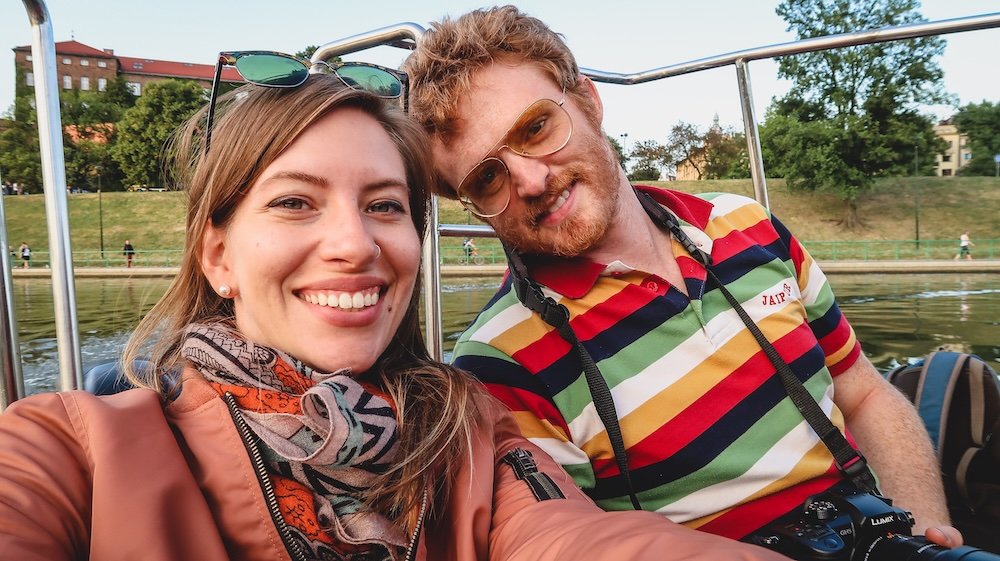
When a city boasts a storied medieval center, a UNESCO-listed Old Town, plus vibrant neighborhoods like Kazimierz, it’s easy to feel overwhelmed. Where do you start? Which corners matter most? How to avoid overpaying or getting stuck in tourist crowds? We’ll address these concerns with practical directions, a curated list of highlights, and tips to streamline your itinerary.
Our Travel Video From Krakow on Samuel and Audrey YouTube Channel (Nomadic Samuel + That Backpacker Hosting)
Why Visit Krakow?
Krakow appeals to nearly all traveler types. History buffs adore its medieval cathedrals and WWII-era sites, while foodies delve into hearty Polish fare and craft beer. Families find child-friendly parks near the center, and couples seek out romantic corners amidst centuries-old walls. Solo backpackers easily connect with the city’s social vibe, and older visitors appreciate its calm, walkable streets. If your idea of adventure includes a tapestry of royal heritage, dynamic culture, and comforting local flavors, Krakow won’t disappoint.
Krakow gracefully merges old and new: a regal cityscape shaped by centuries of Polish monarchs, plus a contemporary, energetic soul fueled by students, artists, and entrepreneurs. Up next, we present the Top 20 Things To Do, spanning must-see landmarks to lesser-known treasures. Then we’ll explore local cuisine, guided tours, accommodations, day-trip potential, transport details, and final reflections. Ready to walk in the footsteps of kings and taste the city’s modern pulse? Let’s begin.
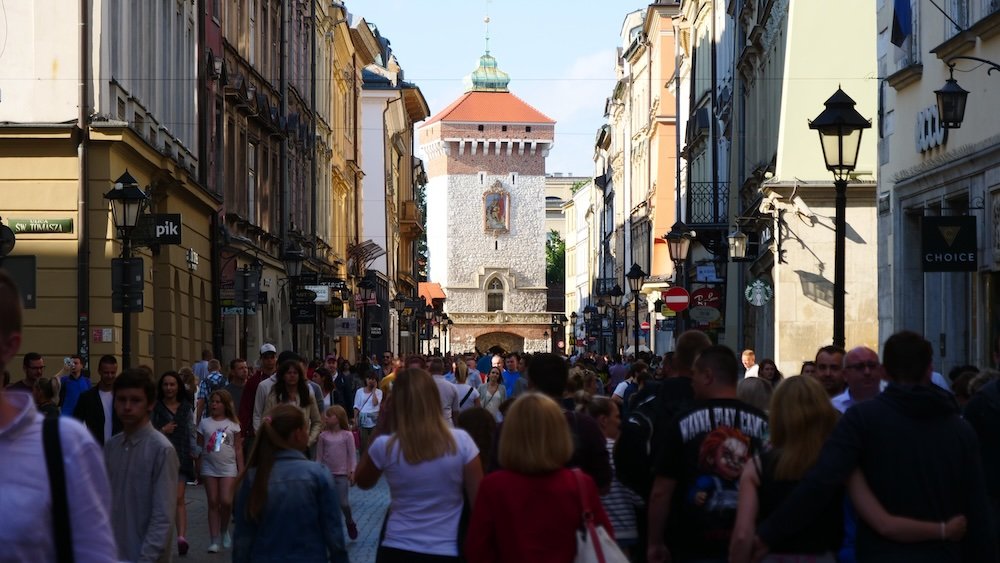
Top 20 Things To Do in Krakow, Poland For Visitors
Krakow brims with royal history, religious heritage, hearty cuisine, and surprising pockets of creativity. This list of 20 things to do merges iconic attractions with offbeat finds. Let’s dive in.
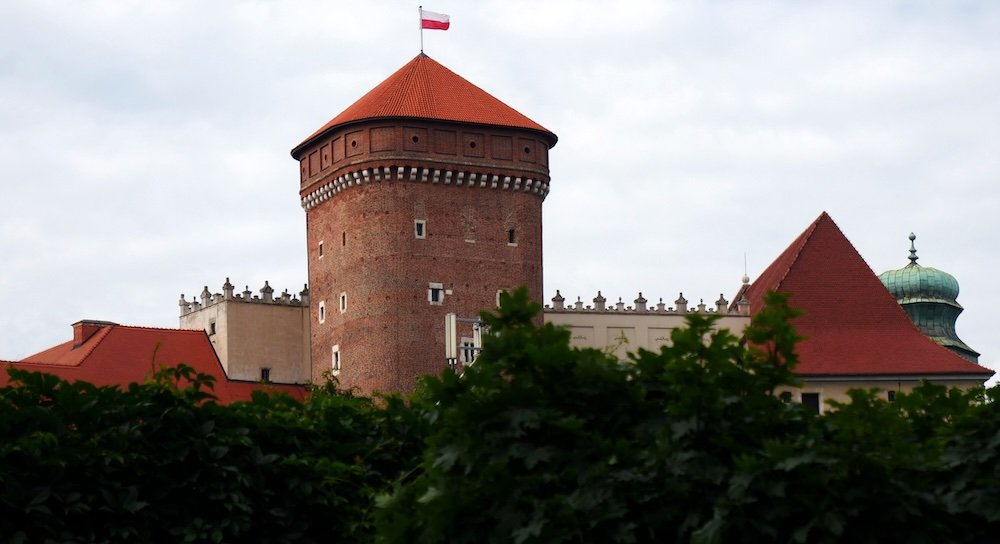
1) Wawel Castle (Zamek Królewski na Wawelu)
Wawel Castle stands majestically on a limestone outcrop above the Vistula River, embodying Poland’s royal tradition. Its courtyards echo with centuries of coronations, royal intrigues, and lavish feasts. Inside, you’ll discover a tapestry of architectural styles—Romanesque remnants, Gothic towers, and Renaissance courtyards seamlessly coexisting. Museum exhibits reveal regal apartments filled with tapestries, period furnishings, and regal insignia that exude monarchical splendor. The Wawel Cathedral next door completes the complex, housing tombs of kings and national heroes. Glimpse the city below from a tower climb, sensing how Krakow’s narrative was shaped in these storied halls.
- Highlights: The State Rooms, Crown Treasury and Armory, and the Sigismund Bell in the cathedral tower.
- Photo Op: Snap a shot in the Italianate courtyard—its arches and columns create a striking backdrop.
- Historical Depth: Each Polish monarch left a mark here; pick up an audio guide to catch the multi-layered stories.
Tip: Arrive early—ticket lines for the Crown Treasury can get long, especially in peak season.
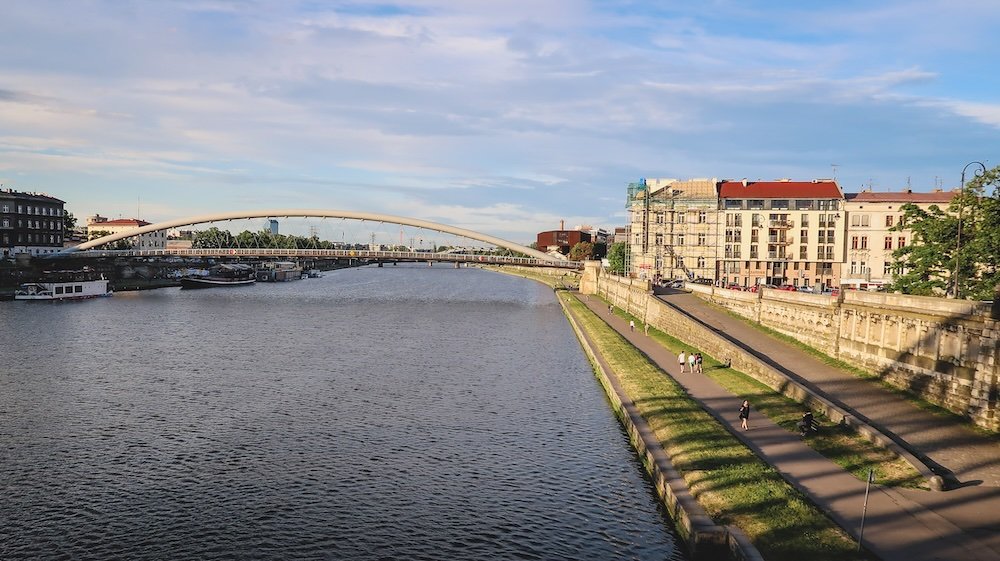
2) Vistula River Walk for Exercise (Wisła)
A Vistula River stroll feels refreshing, especially after hours wandering the Old Town’s cobblestones. The riverside paths stretch wide, inviting joggers, cyclists, or leisurely walkers. Morning runs here offer quiet vistas of Wawel Castle perched overhead. Evenings bring romantic silhouettes with the sun dipping behind spires. You’ll pass cafes, buskers, and possibly a swan or two gliding along the water. This gentle route blends exercise with scenic reward, letting you see Krakow from a more relaxed vantage.
- Distance: Tailor your walk—2 km, 5 km, or more, depending on your mood.
- Benches: Plentiful along the river, so stop to admire city reflections in calm waters.
- Sunset Spot: Closer to Wawel, you’ll find prime angles for golden-hour photography.
Tip: Wear comfy sneakers—the path is paved, but you’ll want good support if you plan a longer jog.
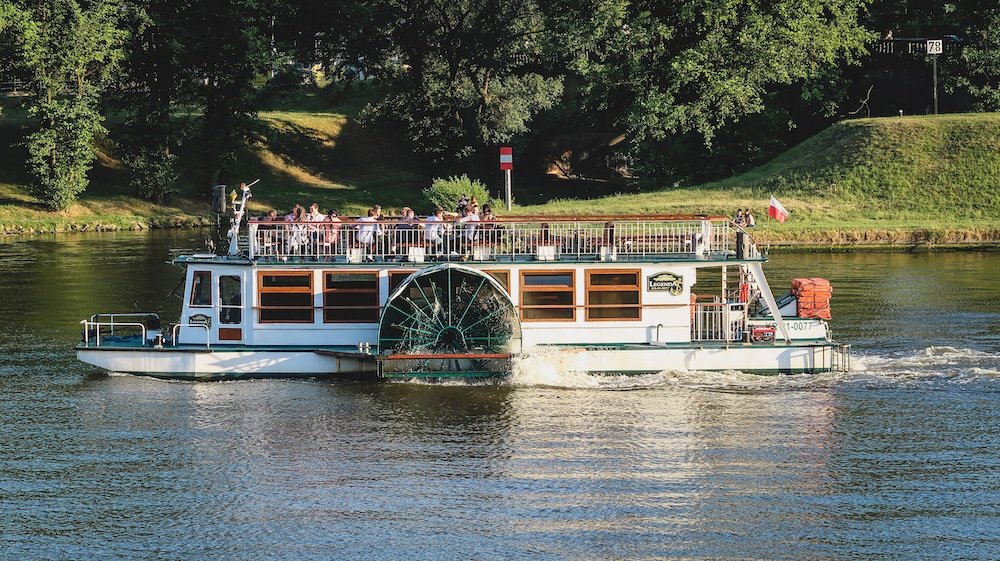
3) River Cruise on the Vistula (Rejs statkiem Wisły)
For a different vantage, hop onto a Vistula River cruise. Boats ply the water, some offering short 30-minute loops around Wawel, while others venture further toward Kazimierz or Podgórze. The experience is low-key: you relax on deck, watch the city’s silhouette shift, and soak in the gentle waves. Commentary might highlight riverside landmarks or local legends, but the real charm lies in drifting past medieval walls and modern buildings side by side. If the sun’s out, the breezy deck can be downright blissful. It’s a quick but memorable way to reframe your Krakow perspective.
- Variety: Basic sightseeing rides or dinner cruises with a meal onboard.
- Seasonal: Peak in summer, fewer boats off-season—check schedules if traveling fall/winter.
- Groups: Families or couples often find this a relaxing break from city bustle.
Tip: Bring a light jacket—the wind on deck can be cool even under sunny skies.

4) The Royal Road or Royal Route (Droga Królewska)
Tracing the Royal Road leads you through Krakow’s historic spine—once the ceremonial path for royal processions. Starting at St. Florian’s Gate, you’ll pass the Barbican, then stroll down Floriańska Street into the heart of the Old Town. The route hits Rynek Główny, continuing to Wawel Castle, weaving you through essential highlights. Look up to spot heraldic symbols, medieval towers, or playful gargoyles lurking on facades. Historically, this path witnessed triumphant entries, regal funerals, and festive parades. Walking it today resonates with that sense of pomp and tradition.
- Major Stops: St. Florian’s Gate, St. Mary’s Basilica, Main Market Square, Wawel Castle.
- Time: A relaxed 1–2 hours, though you can linger for photos, café breaks, or pop-in visits.
- Atmosphere: Vibrant street performers, souvenir stalls, and horse-drawn carriages maintain an old-world flair.
Tip: Go early or late—midday crowds can clog the narrow streets, making leisurely exploration tougher.
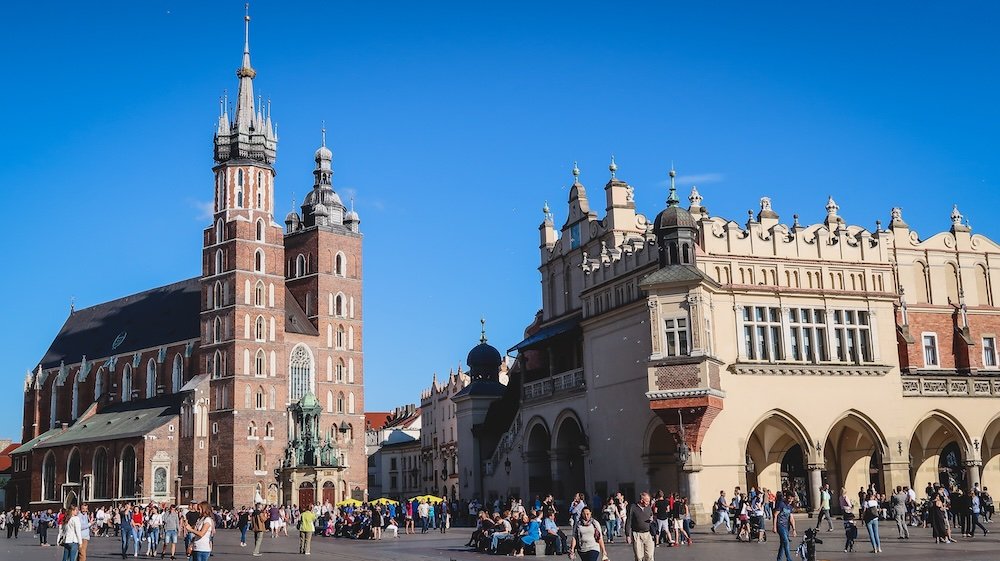
5) St. Mary’s Basilica, Kraków Church (Kościół Mariacki)
St. Mary’s Basilica towers over the Main Square, a vivid Gothic structure sporting two uneven spires. Stepping inside, you’ll encounter richly colored walls, an ornate altarpiece by Veit Stoss, and a star-studded ceiling that feels almost celestial. At the top of each hour, a trumpeter plays the famed hejnal from the taller spire—abruptly cutting off, commemorating a legendary Tatar arrow strike centuries ago. The basilica’s hush contrasts with the lively square outside, offering a moment of reflective awe. Pilgrims and travelers alike savor the uplifting ambiance and meticulously crafted chapels. It’s an unmissable architectural and cultural anchor in Krakow’s heart.
- Entrance: Free for prayer, but a ticket may be needed to tour the altarpiece or higher galleries.
- Hejnal: Runs hourly—watch for the abrupt stop, a cherished local tradition.
- Photography: Interiors can be dim—check if flash is allowed to capture the altarpiece details.
Tip: Climb the tower if time permits—top-tier city views, but the steps can be steep and narrow.
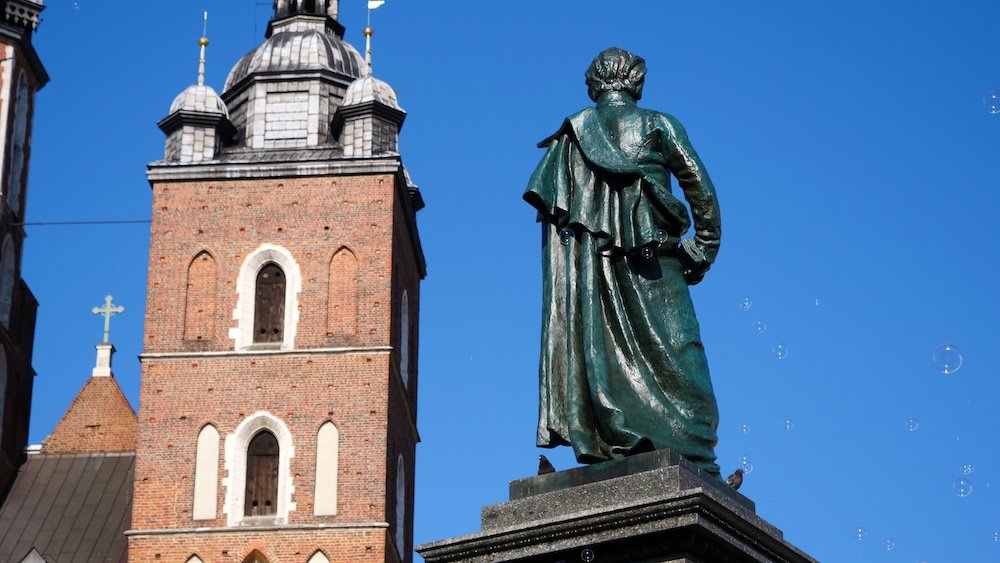
6) Main Square, Kraków Medieval Town Square (Rynek Główny)
At Rynek Główny, Europe’s biggest medieval square, you feel the city’s rhythmic pulse. The Cloth Hall (Sukiennice) dominates the center, once a trading hub for textiles and exotic goods. Musicians, flower vendors, and horse-drawn carriages swirl around the perimeter, adding color and bustle. Sipping coffee at a terrace café might become an impromptu pastime, letting you observe the swirl of tourists, students, and locals. By evening, illuminated buildings exude fairytale charm, and you might stumble upon live music or a seasonal market. You could spend hours here, soaking in architecture, street performances, and the intangible Krakow vibe.
- Don’t Miss: The statue of Adam Mickiewicz, a meeting point for many.
- Shops: Inside the Cloth Hall, stalls sell amber jewelry, folk crafts, and souvenirs.
- Tip: Horse carriages offer short Old Town loops—picturesque, if slightly touristy.
Tip: Explore side streets branching off the square—some host cozy bars or art galleries where crowds thin out.
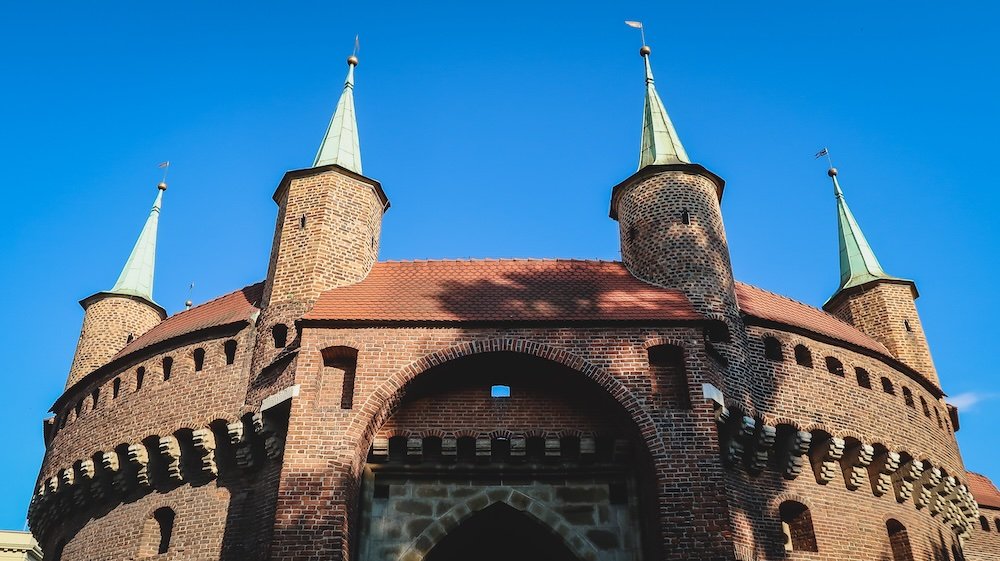
7) St. Florian’s Gate or Florian Gate (Brama Floriańska) and the Kraków Barbican (Barbakan krakowski) in the Old Town
St. Florian’s Gate stands as the only surviving medieval gateway from the city’s once formidable walls. Decorated with a crested eagle emblem, it heralds the start of the Royal Road. Right beside it, the Kraków Barbican (Barbakan krakowski) is a robust circular bastion that once protected the city from northern threats. Walking between these defenses conjures an era of knights, archers, and midnight watchmen. Today, street artists display their paintings along the walls, merging art with ancient stone. Step inside the Barbican (if open) to explore ramparts and arrow slits that still whisper tales of siege and survival.
- Photo Angle: The Gate from Floriańska Street offers a dynamic shot with city hustle in the foreground.
- Museum or Info: The Barbican sometimes hosts small exhibitions detailing Krakow’s fortifications.
- Tip: Some tours start here, unraveling the city’s medieval layout as you follow the Royal Route.
Tip: Pause to watch local artists near the gate—browse or buy a piece if something resonates.
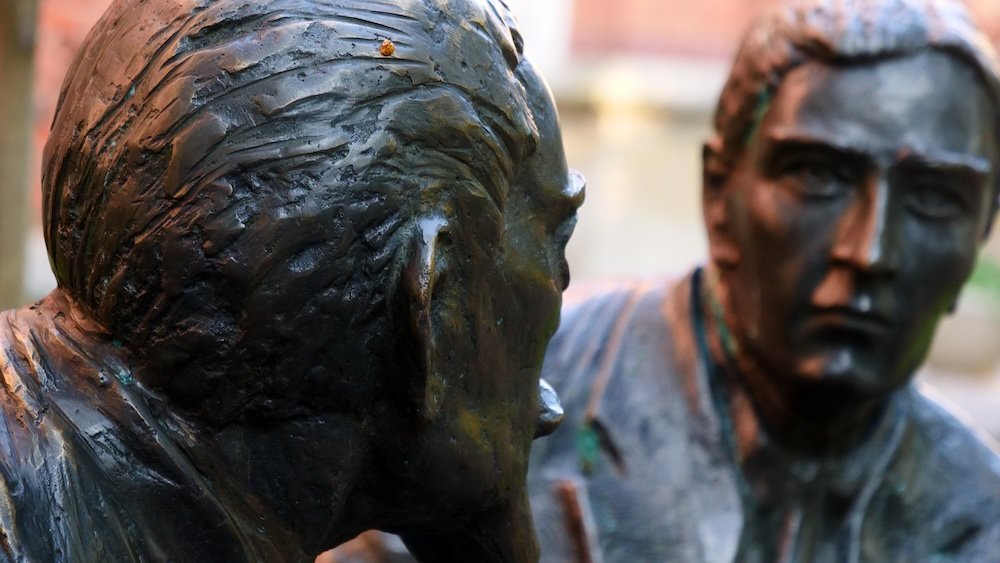
8) Planty Park (Parku Planty Białystok)
Encircling the Old Town, Planty Park offers a green belt that replaced the old city walls. It’s a series of gardens and pathways, each with distinct styles, statues, or floral displays. The shade of mature trees provides respite from the city’s bustle; locals stroll, jog, or lounge on benches reading books. Each segment might reveal a memorial, a fountain, or occasional street musicians playing classical tunes. It’s an easy route for connecting key Old Town points or simply clearing your head after museum hopping. The peaceful ambiance contrasts with the lively squares just steps away.
- Stretch: Roughly 4 kilometers if you circle the entire Old Town perimeter.
- Seasonal: Spring blossoms, autumn’s golden leaves, or winter’s snow-laden branches all give Planty distinct charm.
- Tip: Look for historic plaques that detail remnants of the old fortifications.
Tip: Bring a snack—with ample benches, it’s prime territory for a quick midday break.
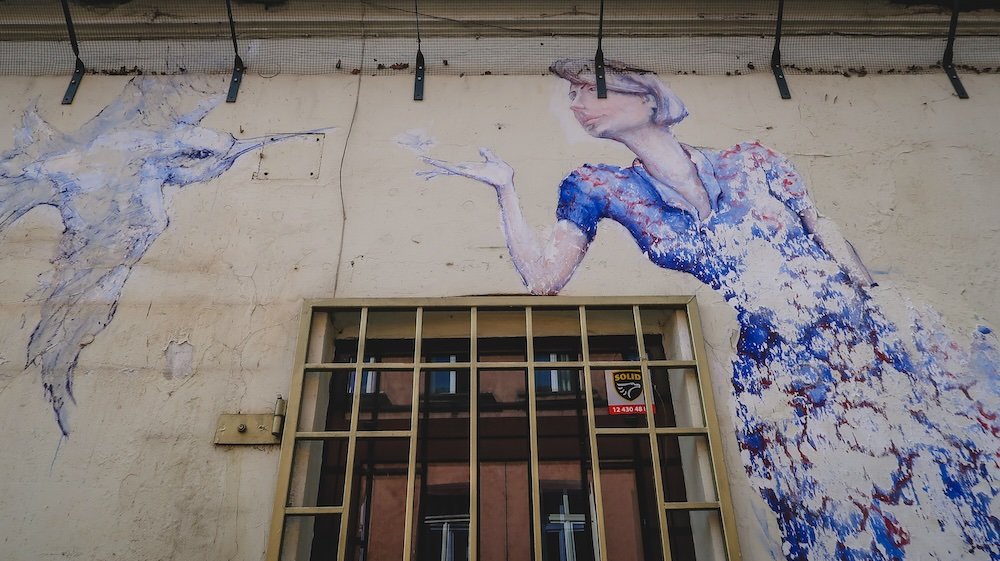
9) Kazimierz neighborhood for street art (Sąsiedztwo Kazimierz)
Once the Jewish quarter, Kazimierz now pulses with bohemian energy, forging new stories atop its layered past. You’ll spot vibrant street art across its alleys—murals on old facades, adding color and commentary. Synagogues stand amid hip cafés, secondhand shops, and alternative galleries. The synergy is tangible: a nod to solemn wartime memories balanced by inventive new waves of culture. Street artists memorialize Jewish heritage or project edgy modern statements, creating a living tapestry. By dusk, bars and clubs awaken, so if you love nightlife with creative undertones, Kazimierz is your playground.
- Key Art Spots: Plac Nowy (New Square) area, home to iconic murals and edgy cafés.
- Cuisine: Falafel, zapiekanka (open-faced baguette pizzas), or artisanal pastries abound.
- Tip: Some free walking tours specifically highlight Kazimierz’s street art and Jewish heritage sites.
Tip: Go midweek afternoon for quieter streets that let you admire murals without weaving through bar crowds.
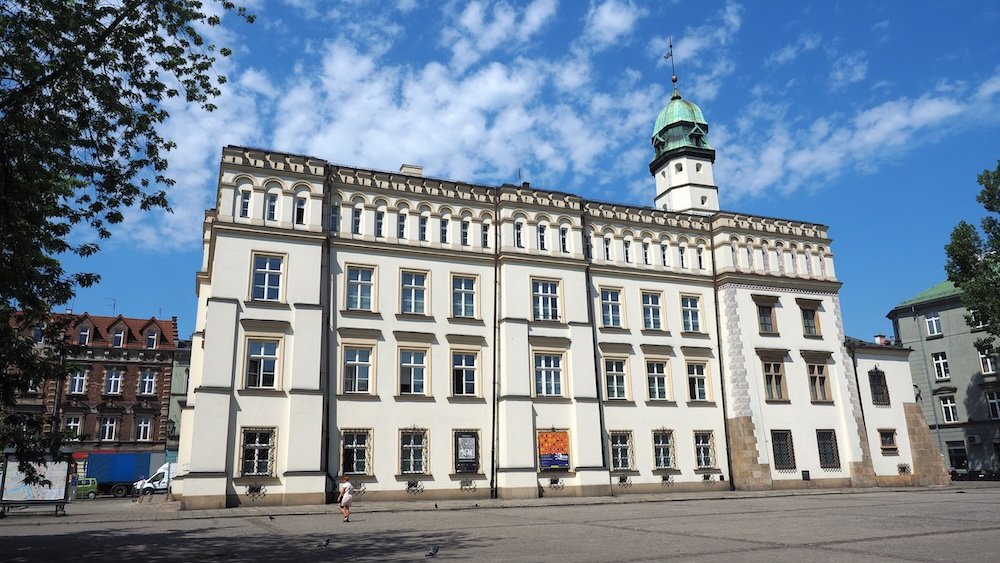
10) Seweryn Udziela Ethnographic Museum of Kraków (Muzeum Etnograficzne im. Seweryna Udzieli w Krakowie)
For a cultural deep dive, the Ethnographic Museum illuminates rural Polish traditions, crafts, and folk costumes. It’s housed in an old townhall building in Kazimierz, so the setting feels historically grounded too. Exhibits range from peasant household re-creations and embroidered garments to lively festivals captured in vintage photographs. You’ll glean how people lived, celebrated, and faced everyday challenges in times past. Interactive elements might let you try weaving or admire vibrant painted trunks. If you love anthropological perspectives, it’s a mesmerizing glimpse into the region’s intangible heritage.
- Hands-On: The museum sometimes runs workshops on crafts or dance—check the calendar.
- Time: ~1–2 hours to absorb main exhibits thoroughly.
- Tip: The building’s central hall often houses a rotating exhibit or special seasonal display.
Tip: Grab an audio guide if available—folk traditions can be intricate, and the added commentary clarifies each display’s nuance.
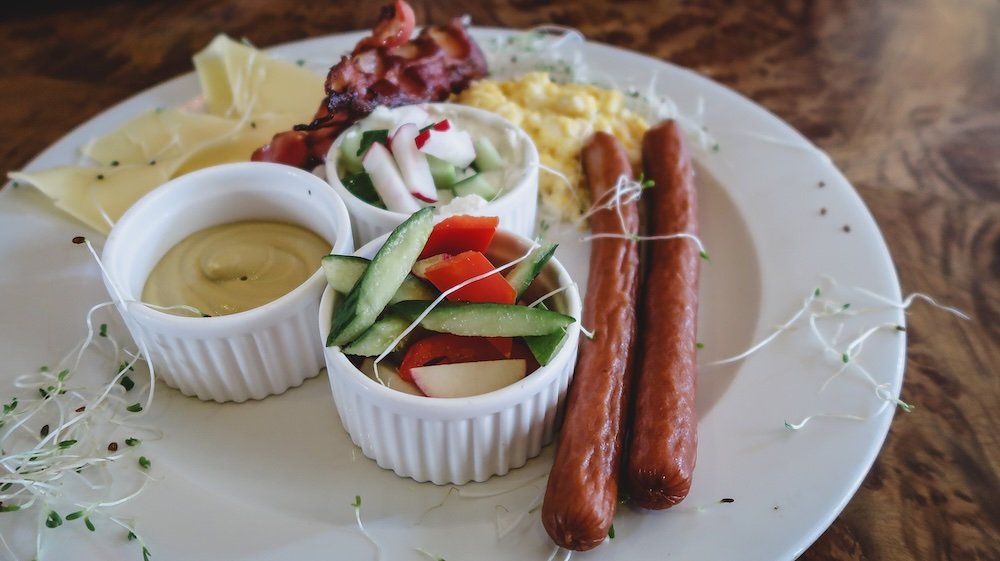
11) Polish Breakfast at Moment restaurant in Krakow (Polskie śniadanie)
Krakow mornings deserve a Polish breakfast done right—consider Moment restaurant as a prime example. Plates might include scrambled eggs, local sausages, pickled cucumbers, and fresh bread slathered in sweet jam or twaróg cheese. Pair it with a strong coffee or fruit infusion. The vibe is cozy but modern, blending old-school flavors with a contemporary café atmosphere. Locals linger over their morning meals, reading newspapers or chatting about the day’s plan. It’s a slow, satisfying way to gear up for castle climbs or museum visits.
- Dishes: Try their “Krakow special” set if offered—often a sampler of multiple items.
- All-Day: Some places serve breakfast well into brunch hours, perfect for late risers.
- Tip: If you see “rurki z kremem” (crispy pastry tubes with cream) on the menu, indulge your sweet tooth.
Tip: Check daily specials—Moment sometimes rotates seasonal items, adding variety to your breakfast feast.
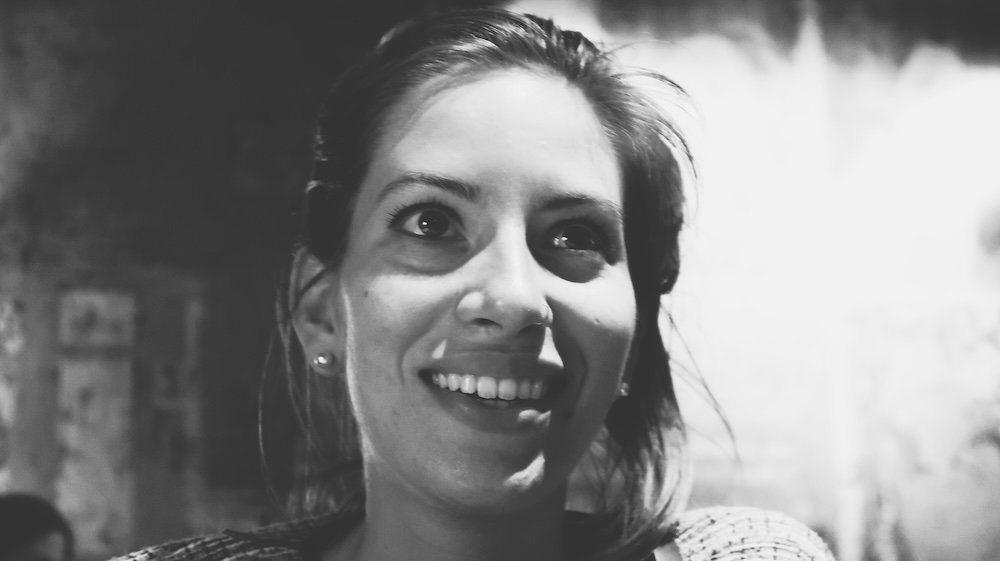
12) Nightlife in Kazimierz (Życie nocne)
After dusk, Kazimierz morphs into a nightlife playground, merging tradition and trend. Bars tucked into centuries-old basements host live jazz, alternative DJ sets, or casual beer gatherings. Candlelit tables on cobbled courtyards create an intimate vibe, while some clubs throb with an eclectic crowd of students, travelers, and local creatives. Expect bohemian décor—mismatched chairs, vintage posters, maybe a quirky statue overshadowing a corner booth. Klezmer music nights nod to the district’s Jewish heritage, adding depth to the usual party scene. If you love discovering hidden bars or dancing until late in non-pretentious spaces, Kazimierz delivers.
- Signature Drinks: Polish craft beer or fruit-infused vodkas are popular picks.
- Food: Late-night zapiekanka stands abound around Plac Nowy, bridging munchies between bar hops.
- Tip: Some bars host weekly quiz nights or jam sessions if you crave more than just a dancefloor.
Tip: Carry some cash—not all smaller bars accept cards, and tip jars sometimes appear on counters.
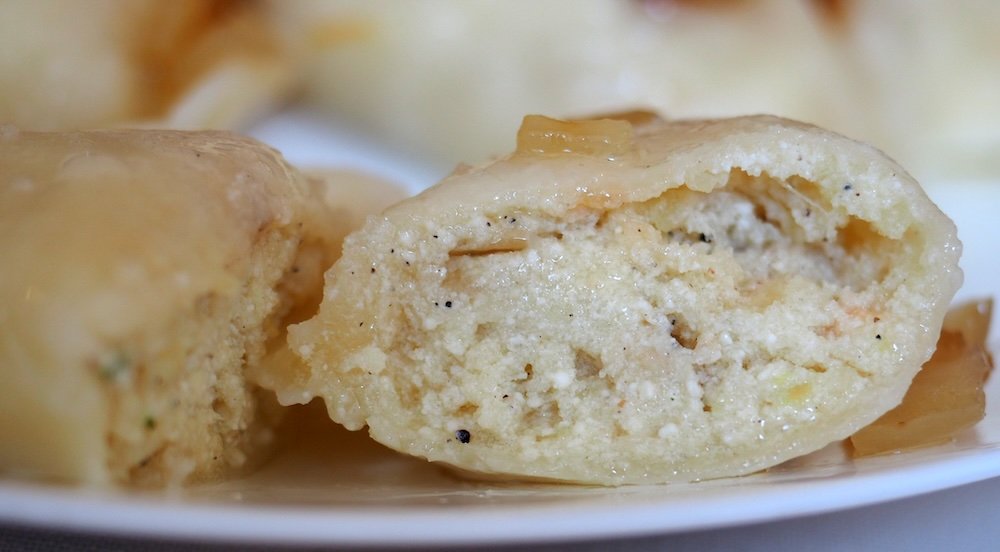
13) Pierogi at Pierogarnia (Polish Dumplings)
No Polish trip is legit without devouring pierogi, and Krakow has countless pierogarnia spots. Stuffings run the gamut: classic ruskie (potato-cheese), meat, sauerkraut-mushroom, or sweet fruit combos for dessert. Some are boiled and tender, others fried to a crisp golden edge. Many pierogarnie let you watch the dough rolling process, adding a homely feel. Toppings might include melted butter, sour cream, bacon bits, or onion. Whether you pick a simple local joint or a more chic eatery, expect these dumplings to rank among your top culinary memories.
- Portion: Typically 8–10 pierogi per plate—heartily portioned, so come hungry.
- Veg-Friendly: Ruskie or spinach-feta variants cater to non-meat eaters.
- Tip: Some shops offer half-and-half plates if you can’t decide on a single flavor.
Tip: Try sweet pierogi with seasonal fruits for dessert—a delightful spin on the savory standard.
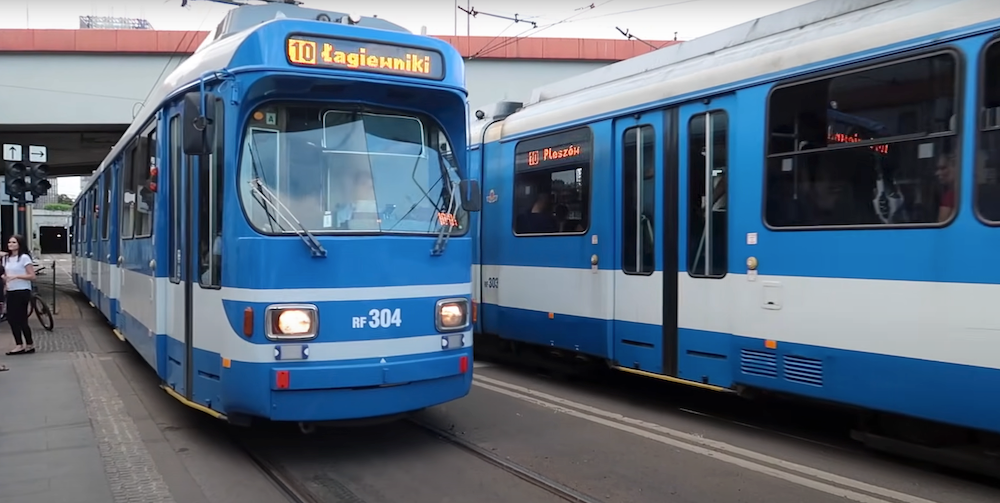
14) Tram Ride in Krakow (tramwajowy)
Riding a tram might seem mundane, but in Krakow, it’s a chance to see daily life from a local vantage. Trams rattle through historical districts, modern neighborhoods, and everything in between. Grab a window seat, watch pastel facades drift by, or pass street murals bridging old walls. Early mornings see office workers, students, and grandmothers carrying market bags, giving you authentic glimpses of city hustle. Some routes skim the outskirts, crossing green belts or glimpsing the river. It’s efficient, cheap, and quietly immersive, especially if you relish casual observations of everyday rhythms.
- Tickets: Time-based (15/30/60 minutes) or single rides—validate once onboard.
- Rush Hours: 7–9 AM, 4–6 PM can be packed, so plan accordingly if you dislike crowds.
- Tip: A day pass might save you money if you plan multiple rides.
Tip: Link your ride with a destination—like heading to Podgórze or beyond the Old Town for lesser-seen enclaves.
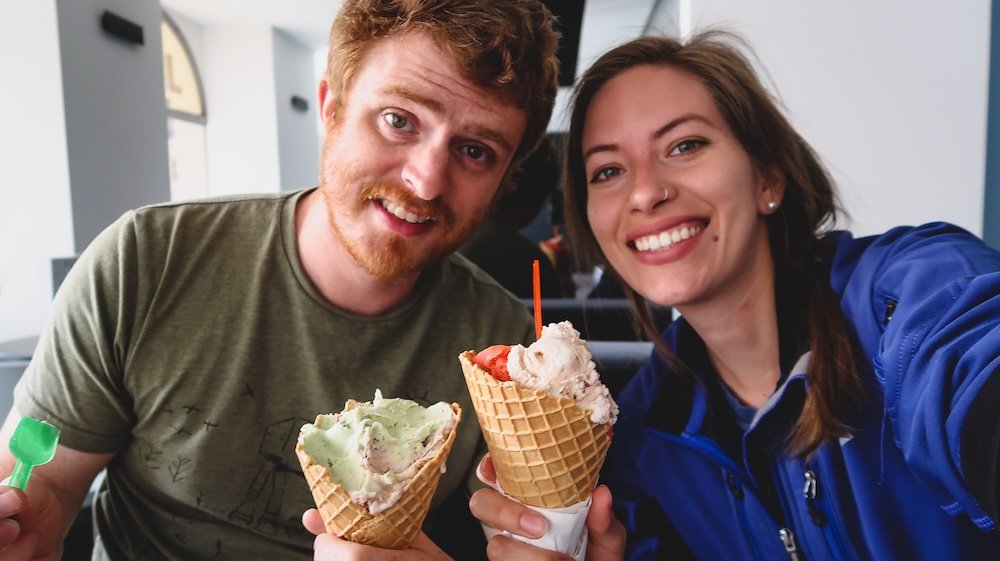
15) Ice Cream at Emil Kręci Lody
Polish ice cream, or lody, holds a special place in local hearts—Emil Kręci Lody is a prime parlor in Krakow. Lines can form fast on warm afternoons, with flavors rotating from classics (chocolate, vanilla) to seasonal or quirky combos (lavender, salted caramel). Scoops are generous, textures luscious, and staff typically let you sample a bit before committing. The vibe is informal: a chalkboard menu, a few stools, maybe an outdoor bench. Kids devour multi-scoop cones, while adult visitors relish a sweet break from city heat. If you’re craving a sugar rush, or simply bridging lunch and dinner, this spot delivers creamy comfort.
- Location: Check if they have multiple branches—some might pop up as temporary stands in summer.
- Seasonal: Autumn could see pumpkin spice or chestnut flavors; spring might bring berry sorbets.
- Tip: Some pair ice cream with Polish doughnut (pączek) for a decadent combo.
Tip: Visit mid-afternoon for shorter lines—peak evening hours can see crowds wanting dessert after dinner.
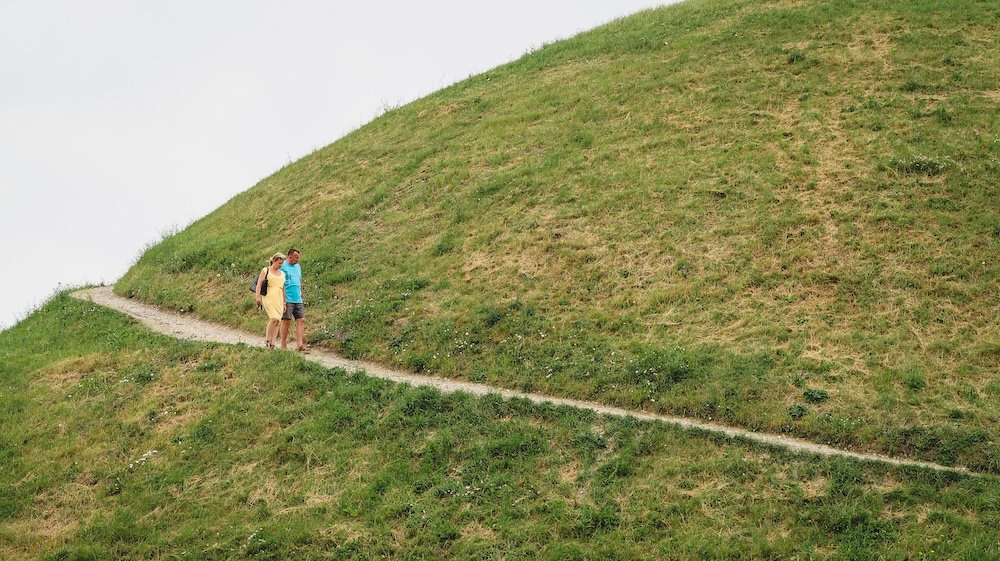
16) Kościuszko Mound (kopiec Kościuszki) in Kraków, Poland
Kościuszko Mound looms on the city’s outskirts, a man-made hill honoring national hero Tadeusz Kościuszko. Ascending the mound reveals 360-degree panoramic views: the Old Town’s spires, Wawel’s silhouette, and, on clear days, perhaps the Tatra Mountains in the distance. Built in the 1800s, it merges patriotic sentiment with a curious engineering feat—soil from all over Poland was used in its construction. Surrounding fortifications host small exhibitions on Kościuszko’s life and military exploits. The breezy summit is a popular romantic or photography spot, especially at sunset. It’s an offbeat excursion that merges nature, patriotism, and a dash of architectural wonder.
- Getting There: Buses from central Krakow or a short taxi ride—some visitors also hike from the city center.
- Time: 1–2 hours including the climb, photo ops, and exhibition browsing.
- Tip: Bring a windbreaker—the summit can get chilly even in mild weather.
Tip: Pair with a picnic—the surrounding area has grassy patches perfect for a quiet snack.
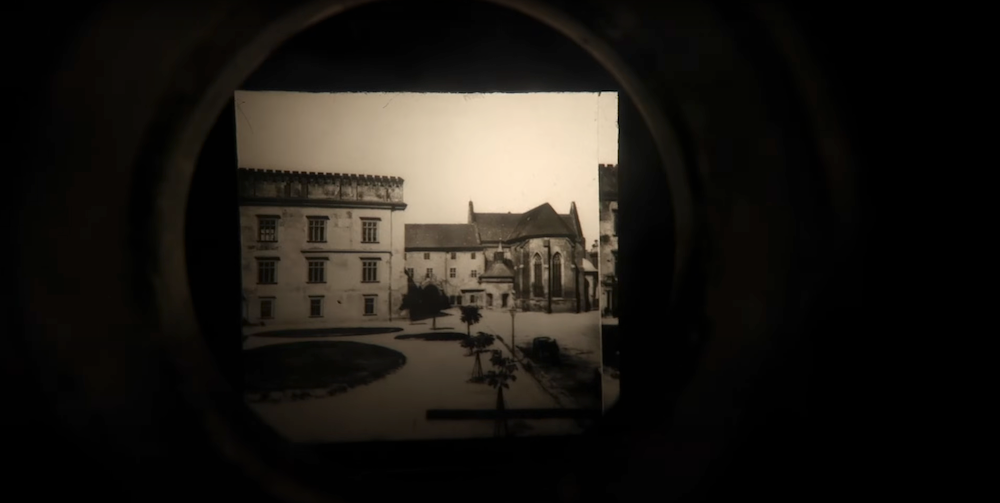
17) Oskar Schindler’s Enamel Factory (Fabryka Emalia Oskara Schindlera)
Schindler’s Factory stands as a poignant memorial to Krakow’s WWII chapter, showcasing how one man saved Jewish workers from Nazi deportation. The museum inside offers immersive exhibits weaving personal narratives, historical footage, and artifact displays. You’ll walk recreated wartime streets, see posters, and sense the dread overshadowing the city’s Jewish district. While Schindler’s story is central, the broader context of Nazi occupation in Krakow resonates through each corridor. Audio guides or guided tours can help decode emotional or complex sections. It’s a sobering stop that fosters reflection, highlighting human resilience amid atrocity.
- Location: In Podgórze, near other WWII-related sites like the Ghetto Heroes Square.
- Crowds: High tourist volume—pre-book tickets or go early to avoid a queue.
- Tip: Some rooms may be intense for younger kids—parents gauge accordingly.
Tip: Take your time—the museum’s narrative is dense; rushing undermines the emotional depth.
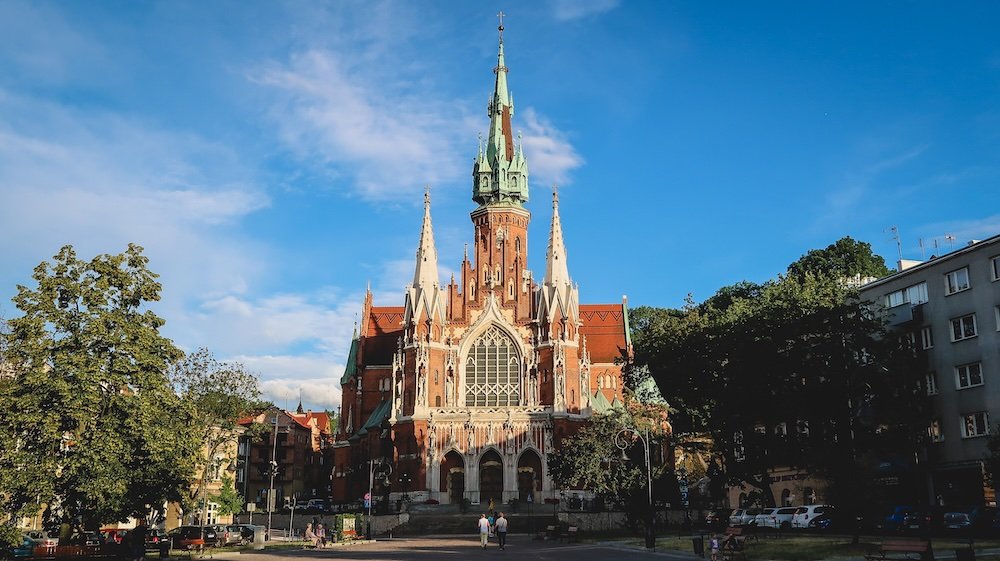
18) Parish of St. Joseph’s Church (Kościół św. Józefa) at Podgórze Square
Podgórze hosts this neo-Gothic gem, St. Joseph’s Church, perched at a scenic square that many tourists skip. The red-brick facade and pointed spires evoke a fairytale church, exuding both grandeur and small-neighborhood charm. Inside, expect stained-glass windows depicting saints and a serene interior that contrasts the lively Old Town vibe across the river. Podgórze itself was once a separate city, so the church anchors local identity. Stroll around the square, discovering quaint cafés or artisan shops in the less-touristy side of Krakow. If you crave a break from mainstream attractions, this corner offers quiet reflection.
- Architecture: Striking facade, carved portals, and a meticulously detailed bell tower.
- Nearby: Ghetto Heroes Square or Schindler’s Factory can combine with this stop for a Podgórze mini-tour.
- Tip: Some evenings see choral recitals—worth checking if you appreciate sacred music.
Tip: Look behind the church for scenic views of the Vistula and Old Town spires in the distance.
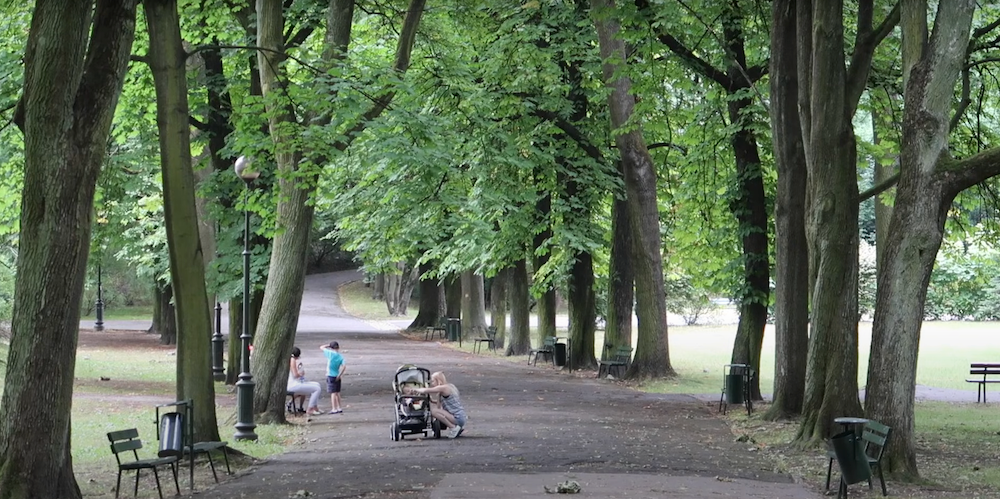
19) Park Bednarskiego (Park im. Wojciecha Bednarskiego)
Tucked in Podgórze, Park Bednarskiego surprises visitors with its leafy canopy, winding paths, and occasional rock formations. Created in a disused quarry, it now brims with chestnut and oak trees, plus meadows perfect for picnics. Locals jog the trails or lounge on benches reading books. Kids roam the playgrounds, while couples or dog-walkers appreciate the chill vibe. The park’s vantage points frame glimpses of Krakow’s skyline, merging nature’s hush with subtle city hum in the distance. If your day demands a green respite, this lesser-known park stands ready.
- History: Named after Wojciech Bednarski, a teacher who championed the park’s creation to revitalize this quarry.
- Flowers: Spring bloom can be colorful, while autumn’s leaves blaze with reds and golds.
- Tip: Some local groups host open-air yoga or small gatherings here—peek local boards for schedules.
Tip: Combine with a coffee from a Podgórze café, then meander the park’s trails at your leisure.
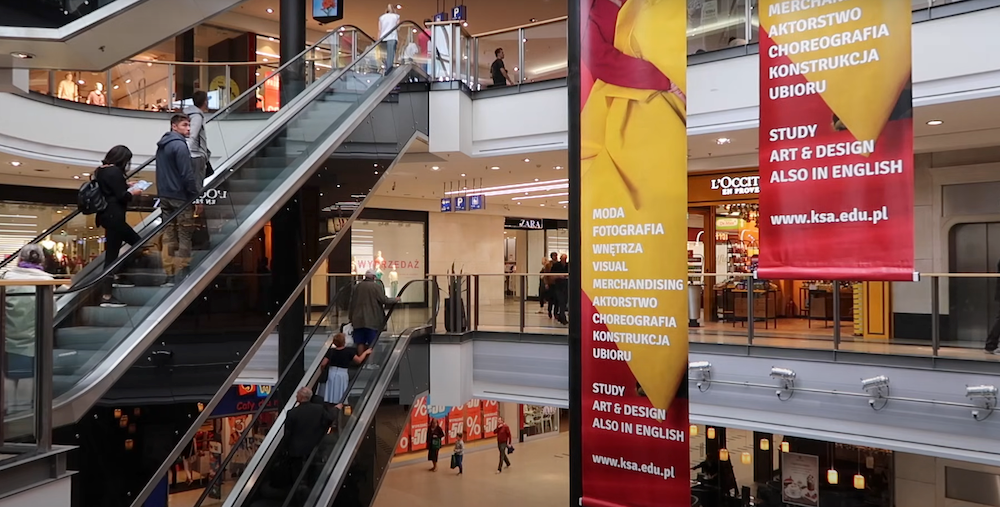
20) Galeria Krakowska (Galerii Krakowskiej) for shopping in Krakow, Poland
If you’re keen on a modern shopping spree, Galeria Krakowska awaits by Krakow’s main train station. The sleek mall houses international brands, Polish boutiques, electronics stores, and food courts for quick bites. It’s a stark contrast to Old Town’s historical cobblestones—an air-conditioned realm of fashion and convenience. Many travelers pop in either upon arrival or departure, hunting last-minute souvenirs or recharging phones on café wifi. The central location can’t be beat, linking directly to trains, buses, and a short walk to the city center. Whether it’s clothes, cosmetics, or just a respite from the weather, this mall covers your pragmatic shopping needs.
- Food Options: Familiar fast-food plus local chain outlets—an easy fallback if you crave something standard.
- Crowd Levels: Weekend afternoons can be busy with locals, but weekday mornings are calmer.
- Tip: Some currency exchange kiosks inside might be pricier than outside—compare rates if exchanging money.
Tip: Use it as a landmark—meeting friends near the main entrance after a day of exploration is hassle-free.
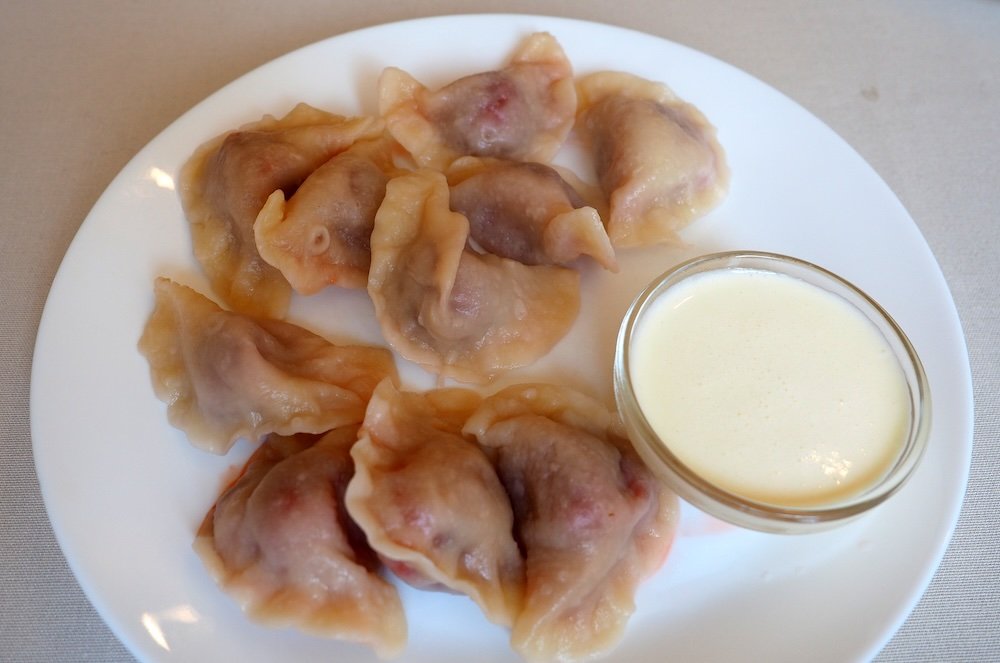
What To Eat and Drink in Krakow, Poland
Krakow’s culinary heritage thrives on hearty Polish classics, innovative spins, and a robust café scene. Locals take pride in their comfort foods, sweet treats, and craft beverages. If your things to do list includes feasting, here’s how to get started.
Our Travel Video (Food Vlog From Krakow, Poland) on Samuel and Audrey YouTube Channel (Nomadic Samuel & That Backpacker)
Pierogi & Traditional Dishes
Pierogi top the list—these doughy dumplings come stuffed with potato-cheese (ruskie), meat, or sauerkraut-mushroom, then boiled or fried. Pair them with melted butter or crispy onions for a satisfying meal. Elsewhere, you’ll see bigos (cabbage stew with meats), schnitzel-like kotlet schabowy, or warming soups like żurek (sour rye soup) or barszcz (beetroot). Many restaurants in the Old Town or Kazimierz serve these staples, often with minor regional twists or creative updates. Don’t forget side dishes: pickled cucumbers, local bread, or fresh salads add finishing touches to your plate.
- Advice: Some spots allow mix-and-match pierogi flavors for a sampler portion.
- Flavor: Hearty, often with bold garlic or onion notes.
- Budget: Even mid-range bistros keep prices modest, so indulging in multiple courses won’t break the bank.
Tip: Look for daily specials—some restaurants feature rotating Polish “lunch sets” at reduced midday prices.
Sweet & Savory Street Snacks
Krakow’s streets entice with zapiekanka (open-faced baguettes topped with cheese, mushrooms, and more) especially in Kazimierz’s Plac Nowy. For a quick sugar rush, stand-based ice cream (lody) or doughnuts (pączki) delight any time of day. If you spot obwarzanek vendors (twisted ring breads akin to bagels), grab one for a salty chew while exploring the Old Town. The synergy of baked goods and city strolling is pure magic—simple, but quintessentially local. Meanwhile, sweet tooths might chase crumbly cheesecake or seasonal fruit pastries in corner bakeries. Street snacks blend convenience with a taste of everyday Krakow life.
- Must-Try: Zapiekanka with garlic sauce or your pick of toppings.
- Cost: Usually cheap, under a few euros for a filling treat.
- Tip: If you see a line, it’s likely the best spot—locals know their favorites.
Tip: Ask for ketchup or spicy sauce with zapiekanka if you crave a tangy kick.
Our Food Vlog From Krakow, Poland on Samuel and Audrey YouTube Channel: Nomadic Samuel + That Backpacker hosting
Cafés & Dessert Culture
Krakow’s café scene merges old-world coziness with new-wave coffee. Expect plush armchairs in centuries-old spaces or hip, minimalist roasters near student hangouts. The city’s slow café culture encourages you to linger over cappuccinos and homemade sernik (cheesecake). Summer might see sidewalk chairs for people-watching; winter fosters toasty fireplaces inside. Some cafés double as art galleries, hosting local exhibitions or small concerts. Whatever the setting, it’s about unwinding with a warm cup, sweet pastry, and the city’s gentle hum.
- Popular Sweets: Sernik (cheesecake), szarlotka (apple pie), or makowiec (poppy seed roll).
- Ambiance: Ranges from antique wooden beams to bright, modern lounges.
- Tip: Some spots feature local roasters or single-origin beans—great if you’re a coffee purist.
Tip: Try midday—less crowded than mornings, and you’ll find prime seating for a relaxed pastry break.
Beer & Vodka Scene
Poland has a burgeoning craft beer movement, and Krakow is no exception. Bars stock local breweries: hoppy IPAs, dark porters, or unique fruit ales. Meanwhile, vodka remains a Polish staple—taste fruit-infused or herbal variations. In Kazimierz or Old Town cellars, you’ll find laid-back bars offering flights of different flavors. Try honey mead (miód pitny) for an ancient, sweet alternative. If you prefer lighter sips, aromatic teas or kompot (fruit punch) may suit your mood.
- Craft Beer Bars: Often list rotating taps, so each visit can yield new brews.
- Vodka Pairings: Some bars serve small plates—think pickles or herring—to complement shots.
- Tip: Pace yourself—Polish vodka can be potent, so small sips beat big gulps.
Tip: Check local brewery tours—some break down the city’s beer evolution and let you sample behind the scenes.
Modern & International Fare
Krakow’s culinary repertoire also welcomes global flavors. With a thriving student population and tourism influx, you’ll see everything from sushi joints and Italian trattorias to Middle Eastern eateries. Street-style burgers or vegan bistros pop up in trendy districts. And don’t be shocked if you spot fusion twists on Polish dishes—like kimchi pierogi or goose confit bigos. This culinary diversity suits travelers wanting variety beyond local classics.
- Where: Starowiślna Street, Kazimierz, or near the railway station often host eclectic restaurants.
- Prices: Range widely, but still cheaper than many Western European cities.
- Tip: For vegetarian or vegan, look for “wegańskie” or “wegetariańskie” signs—Krakow embraces these lifestyles.
Tip: Reserve if you crave a popular dinner spot—weekends can see lines at trendy fusion or themed restaurants.
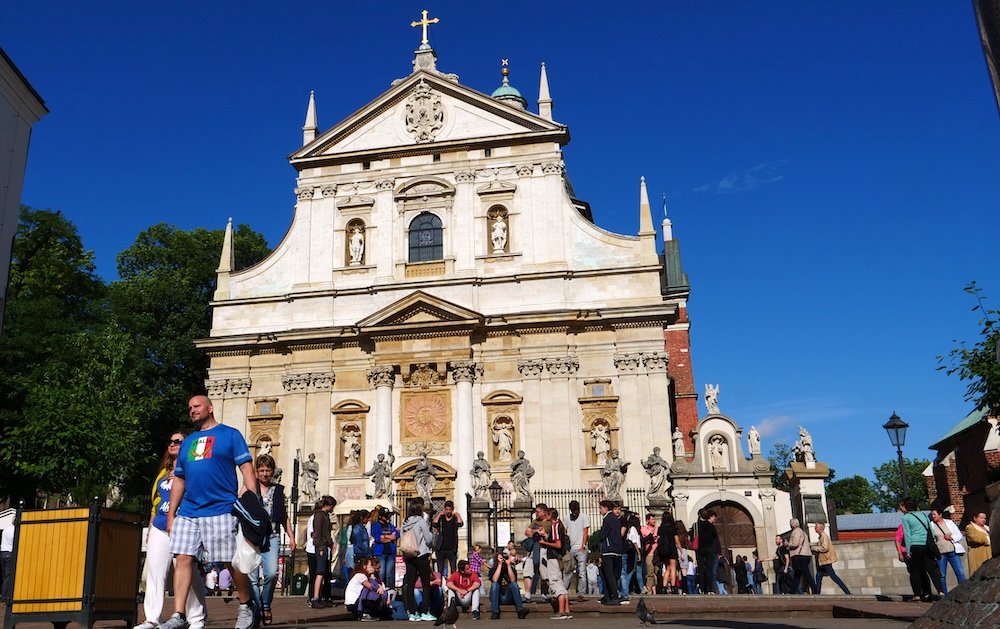
Tours For Visitors To Krakow, Poland
While Krakow begs to be explored at your own rhythm, guided tours can unlock deeper layers of its history, culture, and hidden quirks. From walking the medieval route to plunging into the city’s WWII past or culinary scene, these curated things to do help you see Krakow through a more illuminating lens. Below are recommended tours that blend both iconic highlights and specialized angles.
1) Old Town & Wawel Hill Walking Tour
A classic walking tour often commences in the Main Square, weaving through St. Mary’s Basilica, Cloth Hall, and culminating at Wawel Castle. Guides share fun facts about the hejnal (trumpet) tradition, medieval trade expansions, and royal processions once parading down these streets. Reaching Wawel Hill, you’ll hear the story of the dragon myth plus glimpses into Polish monarchy secrets. Some tours delve inside the Wawel Cathedral, featuring tombs of kings and national heroes. The route typically takes 2–3 hours, perfect for an initial orientation. It’s a broad overview that merges architecture, legends, and city pride.
- Group Size: Typically 10–20 people, though private tours for smaller groups can be arranged.
- Insight: Big events, small anecdotes—like local folklore about nocturnal spooks or architectural Easter eggs.
- Tip: Some tours include skip-the-line tickets for certain castle exhibits.
Tip: Book a morning slot—fewer crowds, cooler weather, and better photo ops with gentler lighting.
2) Kazimierz & Jewish Heritage Tour
Kazimierz hums with a layered past: once the Jewish district, now a bohemian quarter. A Jewish Heritage tour reveals synagogues—both functioning and museum-like—and delves into Holocaust-era history, including the nearby Ghetto remnants across the river. Guides recount poignant tales of families uprooted, how Oskar Schindler’s actions unfolded, and how modern Kazimierz fuses respect for the past with a creative present. You’ll wander streets adorned by street art paying tribute to lost communities. Often, tours wrap at Plac Nowy, where you can sample local bites or reflect on what you’ve learned. It’s a moving, sometimes heavy exploration, but deeply rewarding.
- Duration: 2–3 hours, more if combining with Schindler’s Factory.
- Focus: Cultural transitions, WWII events, present-day renewal efforts.
- Tip: Some tours end with a short Klezmer music performance if scheduled.
Tip: Wear comfy shoes—Kazimierz’s cobblestone alleys can be uneven, and you’ll walk quite a bit.
3) Auschwitz-Birkenau Memorial & Museum Tour
Though emotionally intense, many visitors consider a day trip tour to Auschwitz-Birkenau near Krakow vital. Organized buses or vans ferry you about 70 km west, while knowledgeable guides lead you through the former Nazi concentration and extermination camps. You’ll see barracks, photographs, personal belongings—a haunting testament to humanity’s darkest chapters. The experience is solemn, demanding respectful attire and behavior. Guides often encourage reflection rather than constant photo-taking, urging visitors to absorb the gravity. If you’re prepared for this sobering journey, it offers a profound historical lesson and a vow to remember.
- Booking: Numerous agencies or direct official channels—advanced reservations recommended.
- Timing: A typical half-day or full-day trip, including travel, often ~6–7 hours total.
- Tip: Some tours pair with Wieliczka Salt Mine, but that can be emotionally jarring. Consider separating them.
Tip: Bring minimal luggage—security checks can restrict bigger bags, so a small daypack suffices.
4) Wieliczka Salt Mine Tour
Just outside Krakow, Wieliczka Salt Mine stands as an underground marvel, carved over centuries of salt extraction. Guided tours descend into caverns, chapels (yes, salt chapels!), and galleries lit by salt-crystal chandeliers. You’ll witness sculptures, bas-reliefs, and entire altars meticulously chiseled from salt walls. The labyrinth runs for kilometers, but tours stick to safe routes. The final highlight might be the stunning Chapel of St. Kinga, a subterranean sanctuary. If you’re intrigued by engineering feats, geology, or quirky aesthetics, it’s an unforgettable descent.
- Transport: Minibus or train from Krakow; tours typically handle the ride if you prefer.
- Walking: Count on ~800 steps and comfortable footwear—some floors can be damp.
- Tip: The air supposedly benefits respiratory conditions, so breathe deep.
Tip: Carry a light sweater—underground temperatures hover around 14°C year-round.
5) Food & Craft Beer Tours
For a lighter vibe, a food tour or craft beer crawl merges culinary indulgence with local insights. Guides lead you through hidden pierogarnia (dumpling restaurants), milk bars, or street stands for zapiekanka or sweet pastries. Beer tours highlight Polish brews, from strong porters to hoppy IPAs, often referencing Krakow’s pub culture. You’ll sample small plates, discovering how flavors evolved from regional produce, centuries-old recipes, or modern gastronomic twists. Chatting with chefs or bartenders, you glean personal stories behind each dish or brew. This approach fuses social fun with gastronomic exploration.
- Group: Usually 6–10 people, perfect for friendly conversations.
- Time: 2–4 hours, with 3–5 stops for tasting.
- Tip: Some tours cap free drinks, so pace yourself or buy extras if thirst persists.
Tip: Go empty-stomach—the tastings add up quickly, providing a hearty dinner’s worth of bites.
Our Travel Vlog (Krakow Apartment Tour) in Samuel and Audrey Channel (Nomadic Samuel and That Backpacker as hosts)
Krakow Accommodations Guide: Hotels, Guesthouses and Hostels
Your Krakow experience can hinge significantly on where you sleep—be it a majestic hotel by the Main Square, a cozy guesthouse in Kazimierz, or a social hostel near the train station. Each lodging style shapes how you tackle things to do each day. Here’s how to pick a perfect base:
Hotels Near Old Town
If waking to a view of St. Mary’s Basilica or stepping out onto the Rynek Główny is your dream, Old Town hotels deliver. Many occupy restored townhouses or elegant, centuries-old buildings. Expect swirling staircases, polished floors, and occasional old-world décor—some spots preserve original frescoes or wooden beams. Despite the historical setting, rooms typically include modern comforts: Wi-Fi, AC, and well-maintained en suites. But note, being in the center means higher prices and potential nighttime noise from bars or late walkers. If you want immediate immersion in Krakow’s lively heart, it’s worth the premium.
- Benefits: No commuting—key sites lie minutes away.
- Challenges: Street noise or limited parking—some areas remain pedestrian-only.
- Tip: Some top-tier hotels bundle spa services or guided tours with a booking.
Tip: Request a courtyard-facing room if you’re noise-sensitive—Old Town can hum until midnight.
Boutique Hotels & Guesthouses in Kazimierz
For a bohemian swirl, bunk down in Kazimierz—the Jewish quarter. Boutique accommodations here mix vintage furniture, industrial-chic concepts, or boho flair. The district brims with art galleries, live music bars, and late-night pierogi joints, so stepping outside often means instant culture. Guesthouses might offer intimate common spaces, homemade breakfasts, or local wine recommendations. Overnights here feel more alternative, suiting travelers who appreciate street art, retro bars, and minimal tourist crowds after dusk. A short stroll or tram leads back to the Old Town, bridging a quieter stay with central attractions.
- Price Range: Typically lower than prime Old Town hotels, though upscale boutiques can cost more.
- Atmosphere: Artsy, laid-back, sometimes edgy if near lively nightlife strips.
- Tip: Some places offer free bikes for guests—a fun way to explore Kazimierz’s laneways.
Tip: Research noise levels if you’re next to a party street—weekend bars can blast tunes into the wee hours.
Mid-Range Business Hotels & Apartments
Near the railway station or around business zones, you’ll spot chain hotels or sleek apartment complexes. These may lack Old Town romance but deliver reliable standards—onsite gyms, conferences, maybe minimalistic décor. Some travelers favor them for better value and easy connections to day trips, especially if you plan frequent train rides. Apartments, on the other hand, suit families or extended stays. They include kitchens, living rooms, and washers, letting you live like a local. If your daily agenda is jam-packed with city tours or out-of-town forays, these no-frills approaches can be time- and cost-efficient.
- Rates: Often lower than Old Town hotels, especially if booked in advance or off-peak.
- Dining: Onsite restaurants might be more corporate but still decent, or you can cook in an apartment.
- Tip: Some apartments offer weekly discounts or free parking in a private lot.
Tip: Consider Sunday deals—business-centric hotels may slash rates when corporate travelers depart.
Hostels for Budget & Social Vibes
Backpackers and budget explorers typically flock to hostels near Old Town or the central station. Dorm rooms cost a fraction of hotel prices, freeing up funds for tours and meals. You might find communal kitchens, lounge areas, or nightly events like pub crawls or cultural meetups. It’s an easy way to meet fellow travelers, swap tips, or spontaneously gather a group for a day trip. Lockers usually secure valuables, but you share bathrooms and quiet times can be iffy if folks return from clubs late. If you love that social swirl, it’s a win.
- Price: Dorms around €10–€15, privates ~€30–€40.
- Extras: Common lounge, sometimes free breakfast, or city maps for guests.
- Tip: Some hostels operate in historic buildings with creaky charm or hidden courtyards.
Tip: Read reviews to confirm cleanliness and staff helpfulness—hostel experiences vary widely.
Suburban Escapes & Unique Stays
Craving calmer nights? Consider suburban enclaves or countryside stays near Krakow. Certain B&Bs, farm stays, or small hotels reside on city edges or in adjacent villages. You’ll often get spacious rooms, garden views, or immediate nature. Perfect for travelers wanting quiet after a bustling day, with a short drive or bus ride back to the Old Town. If you have a car or don’t mind a brief commute, these spots can be a budget-friendly oasis. The slower pace might let you experience authentic local life outside the tourist bubble.
- Transport: Check if bus or train lines run frequently, or if you’ll rely on taxis.
- Tranquility: Evening hush guaranteed, though less nightlife or dining at your doorstep.
- Tip: Some properties feature country-lodge vibes or Polish home-cooked breakfasts in backyard patios.
Tip: Weigh commute times—if you want daily Old Town dinners, staying far out can complicate late returns.
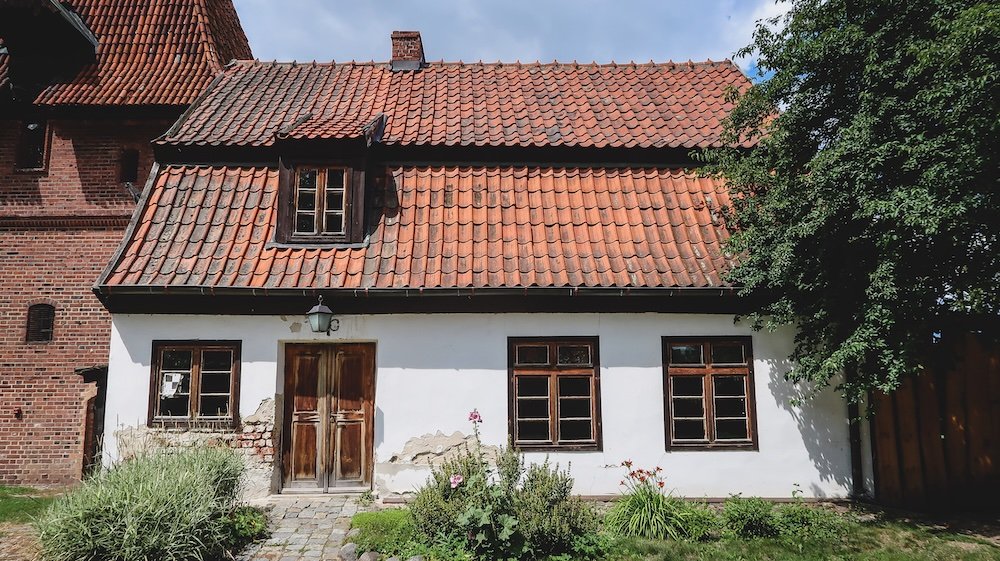
Day Trips From Krakow, Poland
Though Krakow itself brims with things to do, venturing beyond city limits reveals more Polish gems. From solemn sites to breathtaking natural wonders, these day trips expand your understanding of regional heritage and landscapes. Here are five recommended escapes that pair smoothly with a Krakow base.
1) Auschwitz-Birkenau Memorial and Museum
A day trip to Auschwitz-Birkenau is one many travelers deem crucial for deeper WWII context. Located about 70 km west, the site’s stark barracks, watchtowers, and exhibits lay bare Nazi atrocities. Guides walk visitors through the main camp (Auschwitz I) and the larger Birkenau (Auschwitz II), explaining the scale of oppression that took over a million lives. While emotionally heavy, it stands as a testament to remembrance and humanity’s need to stand against hate. Plan for a ~6-hour outing, including transport, guided tours, and personal reflection time. Reservations can fill quickly, so book ahead, especially in peak summer.
- Logistics: Buses or organized tours from Krakow’s main station or city center are common.
- Atmosphere: Somber, with photography regulations to respect victims’ dignity.
- Tip: Some tours pair with Wieliczka Salt Mine, but do consider the emotional toll.
Tip: Bring water and small snacks—on-site facilities are minimal, and you’ll need breaks during the half-day trip.
2) Wieliczka Salt Mine
About 14 km from Krakow, the Wieliczka Salt Mine plunges you into an underground labyrinth carved over seven centuries. Tours navigate through dimly lit corridors, salt sculptures, and awe-inspiring chapels where everything—walls, floors, chandeliers—is salt-based. The highlight, the Chapel of St. Kinga, glows with carved reliefs and statues, all hewn by miners. Expect a 2–3 hour guided exploration, including about 800 steps down. Even if you’re not typically drawn to geology, the artistry and scale impress deeply. Plan a half-day; you can be back in Krakow by lunchtime or pair it with an afternoon outing.
- Health Note: The microclimate supposedly helps respiratory conditions—breathe that salty air deeply.
- Temperature: Steady ~14°C, so carry a light jacket.
- Tip: You’ll exit via a quick elevator ride, different from where you entered.
Tip: Buy tickets online to secure your preferred tour time—summer queues can be long.
3) Zakopane & Tatra Mountains
Zakopane, about two hours south, is Poland’s winter capital, hugging the Tatra Mountains. Even in warmer months, it’s a scenic retreat for hiking, cable car jaunts, or strolling Krupówki Street—lined with wooden chalets and Highlander crafts. Sample oscypek (smoked sheep cheese) from local vendors, accompanied by berry sauces. The mountainous backdrop invites camera-happy visitors—especially if you ride the funicular to Gubałówka for panoramic Tatras glimpses. Winter obviously sees ski enthusiasts and snow-laden landscapes, while summer or autumn reveals lush meadows or fiery foliage. If nature and alpine charm call you, a day in Zakopane feels refreshing.
- Transport: Buses from Krakow MDA station or tours offering direct pickups.
- Activities: Hiking, relaxing at thermal baths, or indulging in mountainous cuisine.
- Tip: The trek to Morskie Oko lake is popular but can get packed on weekends—start early.
Tip: Weather changes rapidly in the Tatras, so layer up even if Krakow’s sunny.
4) Ojców National Park
North of Krakow, Ojców National Park weaves limestone cliffs, dense forests, and curious rock formations into a nature-lover’s haven. The highlight might be the Pieskowa Skała Castle, perched dramatically atop a cliff. Nearby, you can explore caves, wander along scenic trout streams, or admire the famous “Cracow Gate” rock formation. It’s the smallest national park in Poland, but brimming with picturesque nooks and greenery. If you’re itching for fresh air and quick hikes, this escape merges natural beauty with pockets of local folklore.
- Distance: ~24 km from Krakow, easily done by car or bus in under an hour.
- Trail Options: Short loops or more moderate treks, all well-marked.
- Tip: The castle courtyard hosts cultural events in summer—could be concerts or craft fairs.
Tip: Pack a picnic—the park’s vistas make for a memorable lunch setting.
5) Wadowice & Kalwaria Zebrzydowska
Wadowice—birthplace of Pope John Paul II—invites pilgrims or history buffs to see the family home-turned-museum and sample local cream cakes (kremówki) famously tied to him. A short drive away, Kalwaria Zebrzydowska is a UNESCO-listed pilgrimage site with chapels arrayed across bucolic hills, representing the Stations of the Cross. Walking the paths merges spiritual tradition and natural calm. Pilgrims frequently gather in large processions, though casual visitors also appreciate the serene architecture and wooded walks. If you’re seeking a soulful or contemplative day, these two form a neat duo. Return to Krakow by evening, re-energized by a sense of quiet reflection.
- Transport: Buses or tours from Krakow’s main station; self-driving offers more flexibility.
- Highlight: The Pope’s museum in Wadowice, plus the dramatic hillside chapels in Kalwaria.
- Tip: Some tours offer half-day combos—handy if time is tight.
Tip: Try the Wadowice kremówka—a sweet treat beloved in Poland, especially among Pope John Paul II devotees.
Our Travel Video (Bus Ride To Krakow) on Samuel and Audrey Channel (That Backpacker + Nomadic Samuel as hosts)
Krakow Transportation Guide
Navigating Krakow can feel seamless with a bit of planning. The city’s medieval layout plus modern expansions means it has trams, buses, and ride-hailing at your disposal to reach things to do across different zones. Here’s how to move efficiently and with minimal fuss.
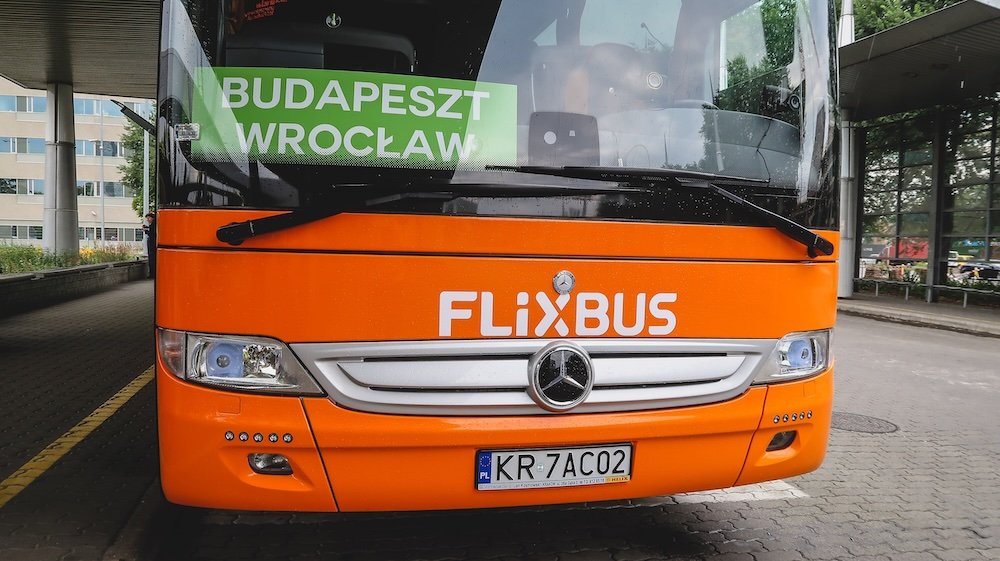
Arriving in Krakow
Krakow John Paul II International Airport (Balice) is around 11 km from the center. Trains run regularly between the airport and Kraków Główny (main station), taking ~20 minutes. Tickets can be purchased at vending machines or on board (though with possible surcharges). Buses (lines 208, 252, or night 902) also connect the airport to central stops. Taxis or ride-shares cost ~70–90 PLN off-peak, though heavier traffic can push that up. If time is tight or luggage heavy, the direct train remains a favorite, dropping you near Old Town’s edge.
- Arrival Tip: Watch for pickpockets at busy stations—keep valuables close.
- Late Flights: Night bus coverage is decent, but double-check schedules to avoid long waits.
- Tip: The train station’s inside the airport building—no need to exit, just follow signs.
Tip: Confirm your hotel’s location—some might be closer to other city stops, so weigh bus vs. train options.
Getting Around the City: Trams & Buses
Krakow’s trams and buses form the public transit core. Tickets are time-based: 20, 50, or 90 minutes, plus daily or multi-day options. Machines at major stops or inside vehicles handle card or coin payments. Validate your ticket once on board to avoid fines—inspectors do random checks. Trams swiftly cross Old Town to outlying districts like Podgórze or Nowa Huta. Buses fill in gaps or run night lines for after-party returns. Rush hours (7–9 AM, 4–6 PM) can see packed vehicles, but nothing unmanageable.
- Night Lines: Identified with “6xx” or “9xx” numbers, though frequency is reduced.
- Maps: Kiosks or phone apps help plan routes.
- Tip: A 24-hour pass often pays off if you anticipate multiple rides.
Tip: Avoid boarding at the last minute—drivers sometimes start rolling as doors shut, so step in carefully.
Taxis & Rideshare
Taxis are easy to find near big squares or the main station. Official cabs run meters; watch for “Radio Taxi” signage or phone numbers on the car. Ride-hailing apps like Bolt or Uber are widespread, often cheaper than cabs. If you’re out late in Kazimierz or Podgórze, rideshare ensures a quick ride back if night trams are sparse. Fares within central areas typically stay under 20–30 PLN unless traffic is heavy.
- Card Payment: Some drivers accept cards, others not—ask or check the app.
- Airport: Taxis might have fixed rates, confirm before departing.
- Tip: Watch out for unmarked or older “taxi” cabs that might overcharge.
Tip: Share your location with your phone’s GPS to ensure drivers don’t take an extended route.
Biking & Scooters
Krakow fosters a mild bike culture, with dedicated lanes along bigger roads or near the Vistula. Rental bikes are available from shops or city bike systems (like Wavelo), though check if it’s fully active in your season. Electric scooters also popped up—easy to unlock via an app, but be mindful of regulations (some areas restrict speed or parking). If you’re comfortable balancing on two wheels, gliding through Old Town or along the river can be a breezy joy. Just watch pedestrians in busy squares—some zones forbid riding through crowds.
- Weather: Winter can be icy, so biking is more popular in spring/summer.
- Cost: Usually cheap for short rides, plus no traffic jam worries.
- Tip: Lock your bike or scooter properly—theft can happen in tourist-heavy spots.
Tip: Plan your route—some older sidewalks or busy roads make riding tricky, so find safer paths or cycle lanes.
Driving & Parking
If you’re plotting day trips or prefer a personal vehicle, you can rent a car. Inside the city center, though, traffic can bottleneck, and parking is often paid or limited, especially in the Old Town’s restricted zones. Street parking requires payment via machines or phone apps, with a max time in certain zones. Garage options exist near Galeria Krakowska or key shopping centers, but weekends and evenings get crowded. Weigh the convenience of your own schedule against possible city congestion.
- Watch Out: Historical core has pedestrian-only sections—follow signage diligently.
- Toll Roads: If you venture outside Krakow to highways, certain sections might require e-tolls or vignettes.
- Tip: If you mostly roam the central area, it’s simpler to rely on trams or cabs.
Tip: Choose a hotel with onsite parking if you must have a car—finding daily spots near Old Town can be a grind.
Day Trip Logistics
Krakow Główny station anchors your easy out-of-town ventures. Trains link you to Wieliczka Salt Mine, Oświęcim (Auschwitz), or other Polish destinations. If you prefer tours, many operators do pickups from central hotels or bus stands near Old Town. Buses also service these routes, but trains are often more reliable for major destinations. Plan day trips with some buffer in case you linger at a site—afternoon or evening trains can fill up, so consider seat reservations if possible. When you return, the station’s near Galeria Krakowska, perfect for a quick meal or grocery run.
- Booking: For popular routes (like Auschwitz, Wieliczka), advanced reservations recommended.
- Peak Times: Early morning trains can be busy with day-trippers—arrive early.
- Tip: Some tours bundle multiple stops in one day, but watch if that feels rushed.
Tip: Pack snacks for day trips—café choices might be limited at smaller stations or tourist sites.
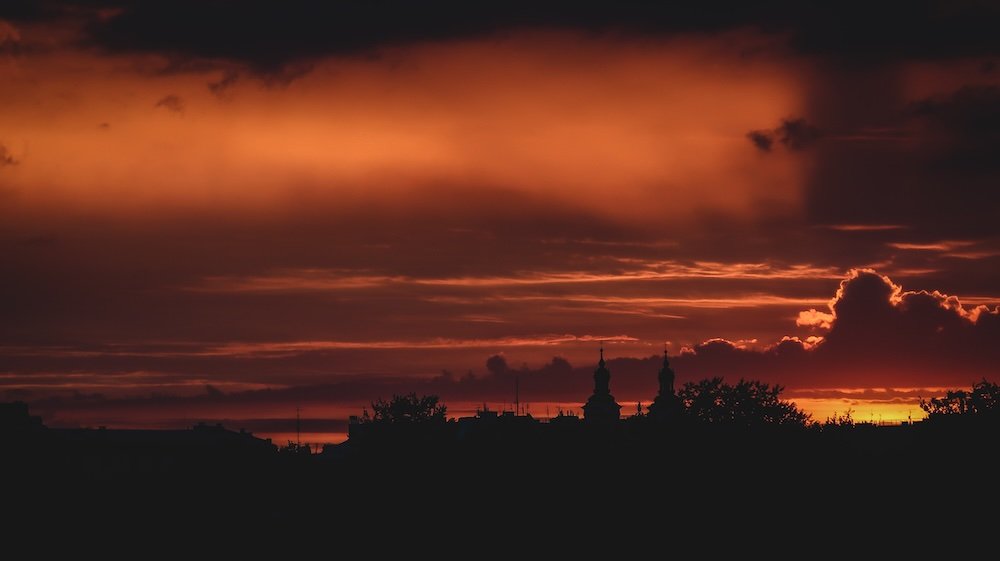
Krakow Travel Guide: Conclusion
Krakow holds a singular spot in Poland: historically regal yet distinctly forward-looking. Meandering through the Old Town, you’ll pass centuries-old walls. Meanwhile, Kazimierz’s vibrant blend of Jewish heritage and contemporary bohemian flair showcases how Krakow perpetually evolves without discarding its past. This synergy—deep tradition plus modern spark—makes the city endlessly captivating.
In your explorations, you may climb the Wawel towers for a panoramic vantage, roam the Planty Park in search of local tranquility, or sample pierogi so hearty they feel like a warm embrace. And that’s just scratching the surface of the things to do that fill each day with unique experiences. By night, the city glows in soft lamp-light, with horse-drawn carriages clopping along the Main Square and jazz notes drifting from basement bars. If you’re adventurous enough, you might ride a tram to an offbeat district or join a late-night gathering in Kazimierz. The contrasts abound, but each feels authentically Krakow, seamlessly stitched together.
Final Thoughts
Logistics needn’t scare you either. The trams, cabs, or short walks link you to most corners. If you have time, day trips to Wieliczka Salt Mine, Auschwitz, or the Tatra-adjacent Zakopane broaden your perspective on Poland’s landscapes and layered history. If not, simply relaxing in a café near the Main Market Square, sipping coffee or nibbling a sweet pastry, can be just as fulfilling. Krakow doesn’t demand you race from site to site; it rewards those who savor the moment, absorbing the city’s intangible warmth.
Yes, some areas can crowd up in peak summer, and certain museums or vantage points require a bit of patience in line. But that’s a small price for the rich tapestry you’ll uncover. Each turn might reveal a hidden shrine, a quirky mural, or a vantage that you’ll recall fondly long after your trip ends. And if your appetite for Polish cuisine grows, there’s no shortage of dumplings, borscht, or sweet treats to keep your taste buds grinning.
At the end of your journey, you’ll likely carry snapshots of architectural marvels, ephemeral tastes of local dishes, or perhaps the memory of a gentle trumpet call echoing at midnight. That’s the magic of Krakow—it infuses the everyday with a sense of historical wonder and modern whimsy. So pack comfortable shoes, stay curious, and immerse yourself in the city’s living story. Because in Krakow, it’s easy to feel as though you’ve stepped into a fairy tale, only to discover a thriving contemporary heart beating just beneath the surface.
